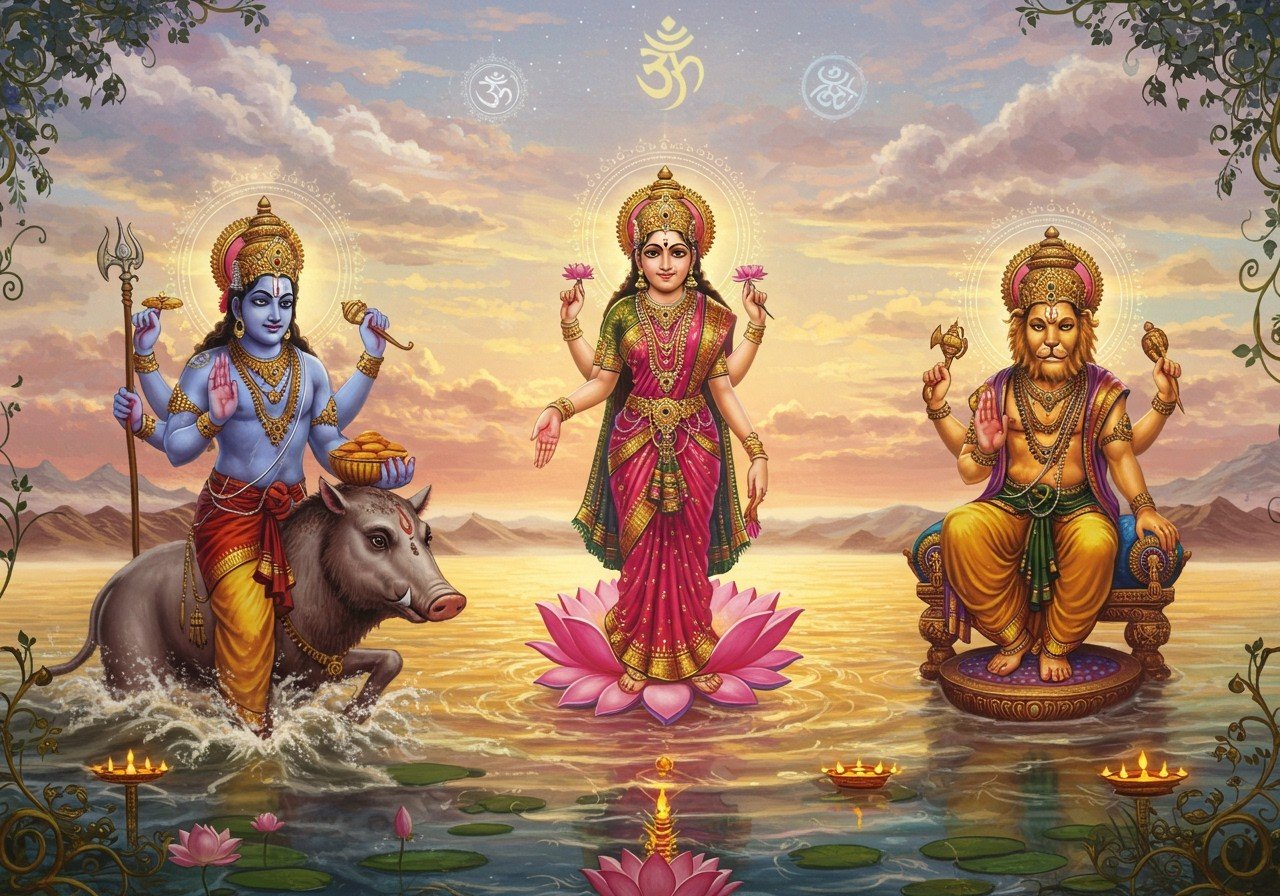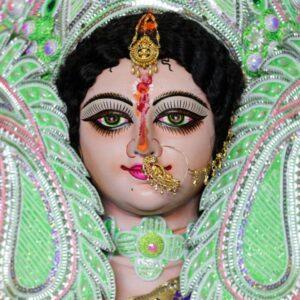Exploring the Divine Trinity: Varaha, Lakshmi, and Narasimha

Delving into the significance of Varaha, Lakshmi, and Narasimha offers a profound understanding of Hindu mythology and its cultural relevance. These avatars of Lord Vishnu symbolize various facets of the cosmos and human existence. This article explores their profound significance, stories, and impact on believers. By examining these divine forms, we uncover their roles in preserving dharma (righteousness) and their representation in rituals, temples, and festivals.
The Varaha Avatar: The Boar Incarnation
The Varaha avatar, one of Vishnu’s ten primary incarnations, is depicted as a boar. It is revered for rescuing the Earth, personified as Bhudevi. The Varaha story underscores the importance of environmental stewardship and the need to protect the planet, illustrating the divine commitment to restoring balance in nature (source 2).
- Mythological Story: Varaha rescues Earth from the demon Hiranyaksha, who had plunged her into the cosmic ocean. This act of salvation highlights Vishnu’s role as the preserver within the Trimurti (source 1).
- Symbolism: Varaha lifting Earth with his tusks symbolizes restoring order and stability. Varaha uniquely embodies the theme of restoration, specifically focusing on Earth and its sustenance (source 3).
- Temples: The renowned Varaha Temple in Khajuraho stands as a testament to this avatar’s significance. The Varaha Lakshmi Narasimha Temple in Simhachalam, Andhra Pradesh, combines the worship of Varaha and Narasimha, highlighting their interconnectedness (source 1).
- Iconography: The boar head and human body symbolize strength and stability, representing Vishnu’s power to overcome challenges (source 4).
- Rituals and Festivals: Varaha Jayanti is celebrated to honor this avatar, signifying the importance of faith and devotion in times of adversity (source 2).
- Teachings: Varaha Purana elaborates on this avatar’s significance, emphasizing the importance of fighting against evil and injustice (source 5).
- Contemporary Relevance: Believers incorporate this avatar into their spiritual practices for protection and stability, seeking to connect with the divine strength represented by Varaha.
The Lakshmi Avatar: The Goddess of Wealth
Lakshmi, the goddess of wealth, prosperity, and fortune, is deeply revered in Hinduism. She embodies abundance and is often invoked for financial well-being and spiritual prosperity.
- Origins and Myths: Lakshmi emerged from the churning of the cosmic ocean (Samudra Manthan), symbolizing the birth of auspiciousness and abundance.
- Forms: Ashta Lakshmi represents eight aspects of wealth and prosperity, showcasing the multifaceted nature of abundance.
- Household Rituals and Festivals: Lakshmi is especially important during Diwali and Lakshmi Puja, where devotees seek her blessings for financial well-being.
- Iconography: Associated with lotus flowers, elephants, and coins, Lakshmi’s imagery evokes purity, strength, and material wealth.
- Temples: The Mahalakshmi Temple in Mumbai is a significant place of worship, attracting devotees seeking her blessings.
- Teachings: Lakshmi Tantra elaborates on her significance, emphasizing the importance of devotion and righteousness in achieving true prosperity.
- Modern-Day Relevance: Lakshmi symbolizes financial well-being and spiritual prosperity, inspiring devotees to seek both material and spiritual abundance.
The Narasimha Avatar: The Man-Lion Incarnation
Narasimha, Vishnu’s fourth avatar, is depicted with a human body and a lion’s head. He is celebrated for destroying the demon Hiranyakashipu to protect his devotee Prahlada. The Narasimha avatar symbolizes the ultimate triumph of good over evil, reinforcing the idea that divine justice prevails (source 2).
- Mythological Story: Narasimha destroys Hiranyakashipu, showcasing divine protection against tyranny (source 3). This story highlights the importance of unwavering faith and devotion, showcasing how genuine belief can invoke divine intervention.
- Symbolism: Narasimha’s fierce form represents destroying evil and protecting righteousness, embodying divine wrath against adharma (unrighteousness) (source 5).
- Temples: The Ahobilam temples in Andhra Pradesh are dedicated to Narasimha, attracting devotees seeking his powerful protection.
- Iconography: Attributes include a lion head, human body, and the depiction of him tearing apart Hiranyakashipu, symbolizing his triumph over evil.
- Rituals and Festivals: Narasimha Jayanti celebrates this avatar, honoring his courage and devotion to his devotees.
- Teachings: Narasimha Purana elaborates on his significance, teaching that true devotion will always be protected (source 5).
- Contemporary Relevance: Believers incorporate this avatar into their spiritual practices for protection, seeking his strength and divine intervention in times of adversity.
The Interconnectedness of the Divine Trinity
Varaha, Lakshmi, and Narasimha are interconnected within Vishnu’s avatars, each addressing different aspects of cosmic balance and human morality. They represent protection, restoration, and prosperity. These avatars are sometimes celebrated together in certain temples and festivals, emphasizing their combined significance in Hindu mythology.
Cultural and Ritual Significance
Rituals, prayers, and ceremonies dedicated to Varaha, Lakshmi, and Narasimha are central to Hindu traditions. Daily puja (worship) practices include offerings and mantras specific to each avatar. Festivals like Diwali for Lakshmi and Narasimha Jayanti hold immense cultural importance.
Poojn.in offers a wide selection of authentic puja items for these deities. You can find Lakshmi idols, Varaha statues, and Narasimha figures, along with other essential items like incense, diyas, and more. Explore our collection to enhance your devotional practices.
Conclusion
Understanding Varaha, Lakshmi, and Narasimha deepens our connection to Hindu traditions. Each avatar plays a unique role in preserving dharma and guiding us towards a balanced life. By incorporating their teachings and rituals, we honor their significance and invite stability, prosperity, and protection into our lives.
To learn more about related deities and practices, explore our articles on Goddess Lakshmi, Lakshmi’s significance beyond wealth, and Lord Ganesha’s various forms.

